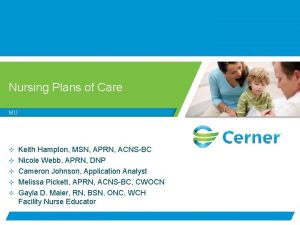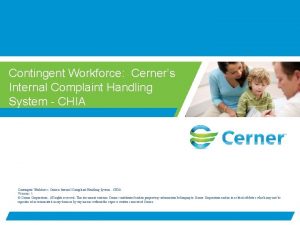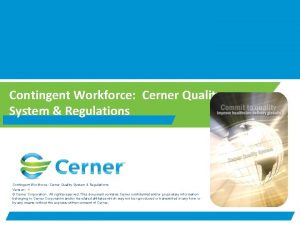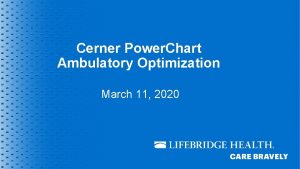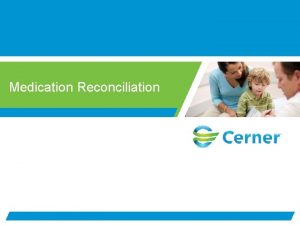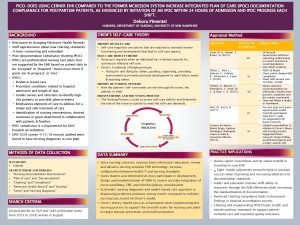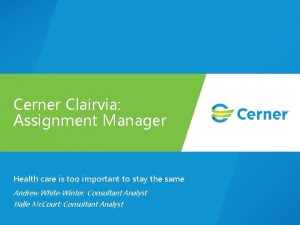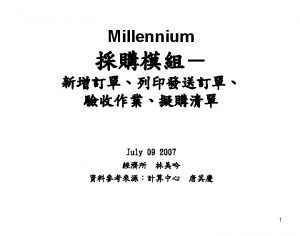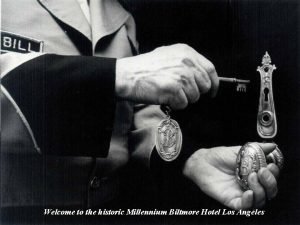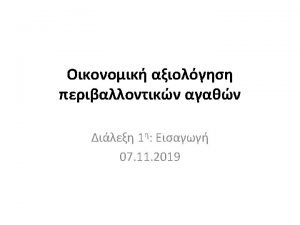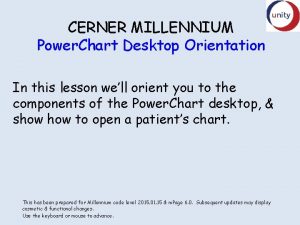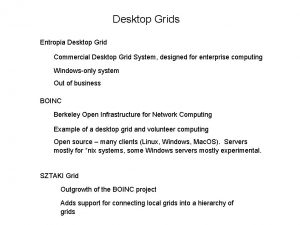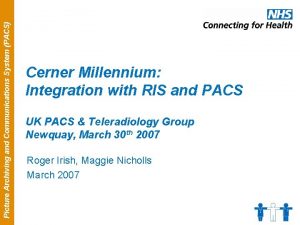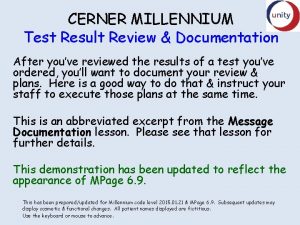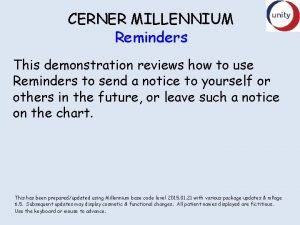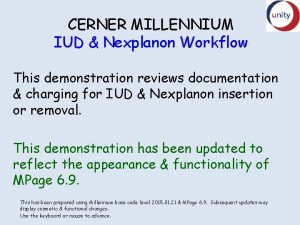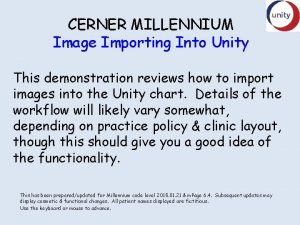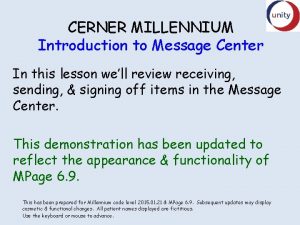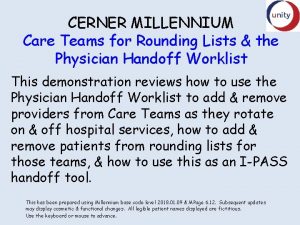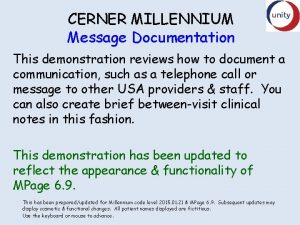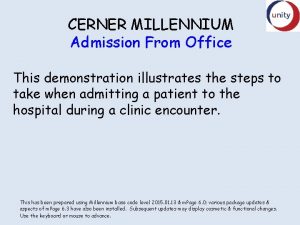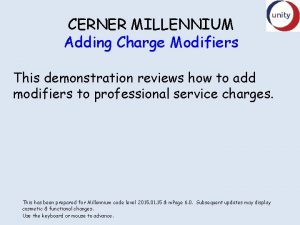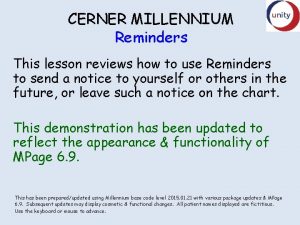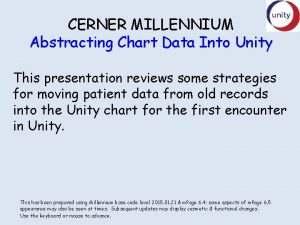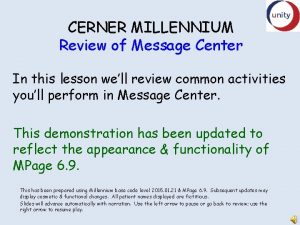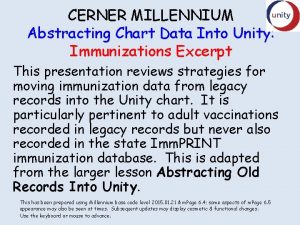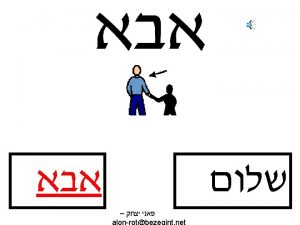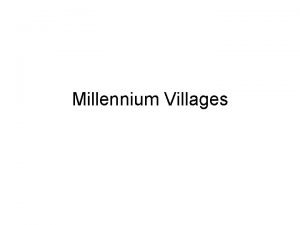CERNER MILLENNIUM First Net Desktop Orientation In this






























- Slides: 30

CERNER MILLENNIUM First. Net Desktop Orientation In this lesson we’ll orient you to the components of the Emergency Department First. Net desktop, & show to open a patient’s chart. This has been prepared for Millennium code level 2015. 01. 15 & m. Page 6. 0. Subsequent updates may display cosmetic & functional changes. Use the keyboard or mouse to advance.

You’ll be shown how to access Cerner Power. Chart, & be given a username & password.

When you first log on, you’ll land on ED Launch. Point, essentially your home screen. You can always return to this screen by clicking the ED Launch. Point button.

Like most Windows programs, you’ll see a Menu Bar across the top. This can be used to change views & perform several functions, but for the most part it just duplicates functionality you’ll access in other ways throughout the program.

Below that you’ll find something else common to many Windows programs—a toolbar. You’ll use some of these buttons periodically throughout your work session.

ED Launch. Point is currently showing all patients.

There are buttons & dropdown lists to give you an assortment of other views. This button allows you to add pre-arrival patients.

There a lot of colors & symbols on the screen. Let’s take a moment to review some of these.

Clicking the tab at the far left will bring up a list of notifications on the patient.

Room & Patient Information are self-explanatory. This column lists acuity level. This column shows the initials of the physician, midlevel, resident, & nurse assigned to the patient.

Chief complaint displays under Patient Details. Clicking the Comments button allows entry of comments.

The Heart icon is for Vital Signs. Here you see it collapsed. Clicking the carat toggles to an expanded view.

These icons represent several types of orders, & give some graphic feedback about what has been done or is in progress. We just discussed Vital Signs. The others, from left to right, are Meds, Labs, EKG, Radiology, & Patient Care items. (We’re not currently using the Telephone icon. ) Clicking any one of these icons, or the Patient’s name, brings up further details.

Clicking the patient’s name brings up the Patient Summary. You can review data & launch order search.

This is the Vital Signs screen.

This is the Medications screen.

This is the Labs screen.

This is the EKG screen.

This is the Radiology screen.

And finally, Patient Care. Click Close when done.

Also notice that hovering over these icons will show some of the information related to them.

The next two columns give information about patient status & length of stay. Hovering gives you more detail here as well. (LOS numbers here an artifact of the demo. ) Doc shows status of documentation, & launches documentation.

On many screens you’ll see a refresh button like the one you see in the upper right corner. You can always use this to update the displayed screen to the most current data.

The upper right corner also gives you a way to search for & open a patient’s chart. The Recent dropdown list will show you the last few charts you’ve opened.

You can also type a name in the Search Box, then hit Enter or click the magnifying glass button.

A window opens with your search results. The more information you enter, the more the list will narrow down.

When you click on one of the patients at the top, it will display a list of encounters at the bottom. You’ll usually want to pick the most recent encounter at your venue.

As you open an encounter on the patient’s chart for the first time, you’ll be asked to state your professional relationship to the patient. Think of this as an explanation for why you’re viewing this patient’s record. If you already have an established relationship with the patient, e. g. , you’re the PCP, you won’t see this.

When the patient’s chart is open, you’ll see a splash of useful information at the top in the Banner Bar. When you hover an item on the Banner Bar, it will often display more information. For example, here it shows the encounter date you chose when opening the chart.

That should help orient you to the screens you’ll see in First. Net. We’ll go more into usage in another exercise.
 Ethnocentric approach example
Ethnocentric approach example Cerner ipoc
Cerner ipoc Workforce cerner
Workforce cerner Workforce cerner
Workforce cerner Cssr-s risk assessment
Cssr-s risk assessment Cerner junefordbloomberg
Cerner junefordbloomberg Cerner riverport campus
Cerner riverport campus Cerner ambulatory organizer
Cerner ambulatory organizer Cerner icons
Cerner icons Cerner care compass
Cerner care compass Cerner smart templates
Cerner smart templates Kathleen fisher cerner
Kathleen fisher cerner Cerner ipoc
Cerner ipoc Clearvia reviews
Clearvia reviews Millennium geospatial
Millennium geospatial Third millennium
Third millennium Millennium prize problems
Millennium prize problems Millennium ecosystem assessment synthesis report
Millennium ecosystem assessment synthesis report Innopac millennium
Innopac millennium Conclusion of millennium development goals
Conclusion of millennium development goals Chapter 26 section 1 the 1990s and the new millennium
Chapter 26 section 1 the 1990s and the new millennium Poincare conjecture solver
Poincare conjecture solver Millennium biltmore hotel deaths
Millennium biltmore hotel deaths Millennium science complex
Millennium science complex Financial service partners
Financial service partners Millennium ecosystem assessment
Millennium ecosystem assessment The difference between mood and tone
The difference between mood and tone Millennium
Millennium Millennium
Millennium Millennium clock tower edinburgh
Millennium clock tower edinburgh Millennium planters
Millennium planters

